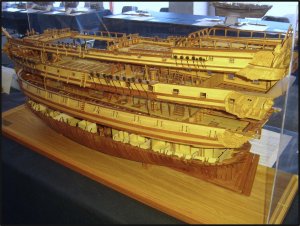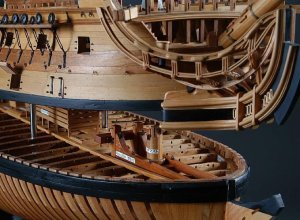I found some Cut Away models of sailing ships, which are showing the internal structure and could be for some interest for Plank on Frame (POF) modelers
BELLONA (1782)
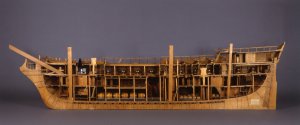
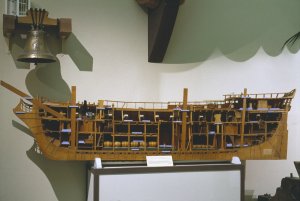
https://digitaltmuseum.se/021176541639/bellona-1782
https://digitaltmuseum.se/021015976368/utstallning-i-flottans-paviljong
KRONPRINS GUSTAF ADOLF (1782), 62 gun ship




https://digitaltmuseum.se/021176498282/kronprins-gustaf-adolf-1782
https://digitaltmuseum.se/011014855603/b1392
Scale: 1:24. A contemporary half-longitudinal model of the 80-gun two-decker HMS ‘Collingwood’ (1841) built plank on frame and mounted on its original wooden baseboard. Externally, some of the planking has been omitted to show the layout of the framing whilst internally, the deck beams have been cut away to show the composite construction of the hull with the use of iron riders, diagonal braces and knees. The combination of iron and wood enabled larger and stronger ships to be built. Originally designed by William Symonds in 1832, the ‘Collingwood’ was eventually launched at Pembroke Dockyard in 1842. Measuring 190 feet in length by 56 feet in the beam and a tonnage of 2589, she required a complement of 720 men to operate the 32-pounder guns. She was later converted to screw propulsion at Chatham Dockyard in 1861 although not fitted for sea service. Her machinery was fitted later but as was the similar fate of some of her sister ships, this proved to be un-economical and she was sold for breaking to Castles of Charlton in 1867
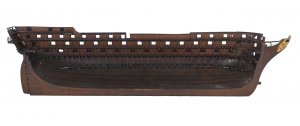

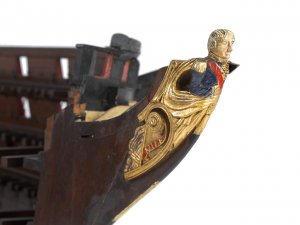
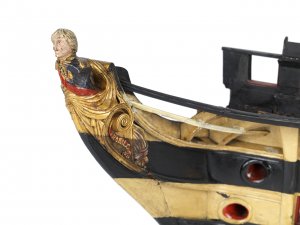
https://collections.rmg.co.uk/collections/objects/66765.html
Scale: 1:24. A model of a half midship section of Royal George (1756) made entirely in wood with metal and organic fittings and painted, stained and varnished in realistic finishes. The hull is painted white below the wales, the wale itself is painted black and the hull above the wale is stained and polished wood. The upper hull is sectioned and scored to resemble planking that has been fixed to the frame with treenails. The section of frieze has been finely painted showing trophies and medallions on a blue ground. The inboard hull is painted black to just above the gun deck and also the lower part of the middle deck. The gun deck beams, knees and planking are polished wood. The middle deck knees and beams are painted red and the upper deck knees and beams are cream. All four decks are stained and polished wood and scored to resemble planking. The inboard hulls of the upper and quarter decks are painted red with blue above. There are ten gunports, two on the quarterdeck, the remainder have lids that can be opened (one lid missing). A section of channel is positioned between the upper and quarterdecks. Four guns on wooden carriages are shown, one on each deck. The guns are made from turned wood painted grey and the carriages are red with sea service trucks. The model is displayed on a rectangular wooden baseboard with bevelled edges and turned feet. The model is supported along its keel section by two brass stabiliser supports

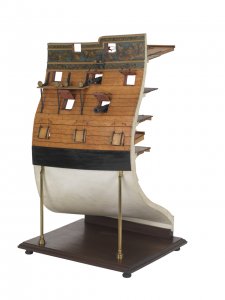
https://collections.rmg.co.uk/collections/objects/66456.html
"linjeskepp om 74 kanoner enlig af Chapmans ritningar från 1792, vilka, lätt modifierade, användes för byggandet av tre linjeskepp: Gustaf IV Adolf (sjösatt 1799
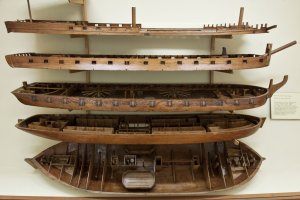
https://digitaltmuseum.se/011024822503/fartygsmodell
BELLONA (1782)


https://digitaltmuseum.se/021176541639/bellona-1782
https://digitaltmuseum.se/021015976368/utstallning-i-flottans-paviljong
KRONPRINS GUSTAF ADOLF (1782), 62 gun ship




https://digitaltmuseum.se/021176498282/kronprins-gustaf-adolf-1782
https://digitaltmuseum.se/011014855603/b1392
Scale: 1:24. A contemporary half-longitudinal model of the 80-gun two-decker HMS ‘Collingwood’ (1841) built plank on frame and mounted on its original wooden baseboard. Externally, some of the planking has been omitted to show the layout of the framing whilst internally, the deck beams have been cut away to show the composite construction of the hull with the use of iron riders, diagonal braces and knees. The combination of iron and wood enabled larger and stronger ships to be built. Originally designed by William Symonds in 1832, the ‘Collingwood’ was eventually launched at Pembroke Dockyard in 1842. Measuring 190 feet in length by 56 feet in the beam and a tonnage of 2589, she required a complement of 720 men to operate the 32-pounder guns. She was later converted to screw propulsion at Chatham Dockyard in 1861 although not fitted for sea service. Her machinery was fitted later but as was the similar fate of some of her sister ships, this proved to be un-economical and she was sold for breaking to Castles of Charlton in 1867




https://collections.rmg.co.uk/collections/objects/66765.html
Scale: 1:24. A model of a half midship section of Royal George (1756) made entirely in wood with metal and organic fittings and painted, stained and varnished in realistic finishes. The hull is painted white below the wales, the wale itself is painted black and the hull above the wale is stained and polished wood. The upper hull is sectioned and scored to resemble planking that has been fixed to the frame with treenails. The section of frieze has been finely painted showing trophies and medallions on a blue ground. The inboard hull is painted black to just above the gun deck and also the lower part of the middle deck. The gun deck beams, knees and planking are polished wood. The middle deck knees and beams are painted red and the upper deck knees and beams are cream. All four decks are stained and polished wood and scored to resemble planking. The inboard hulls of the upper and quarter decks are painted red with blue above. There are ten gunports, two on the quarterdeck, the remainder have lids that can be opened (one lid missing). A section of channel is positioned between the upper and quarterdecks. Four guns on wooden carriages are shown, one on each deck. The guns are made from turned wood painted grey and the carriages are red with sea service trucks. The model is displayed on a rectangular wooden baseboard with bevelled edges and turned feet. The model is supported along its keel section by two brass stabiliser supports


https://collections.rmg.co.uk/collections/objects/66456.html
"linjeskepp om 74 kanoner enlig af Chapmans ritningar från 1792, vilka, lätt modifierade, användes för byggandet av tre linjeskepp: Gustaf IV Adolf (sjösatt 1799

https://digitaltmuseum.se/011024822503/fartygsmodell




